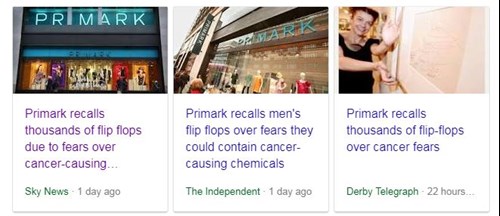If you have already bought your summer holiday wardrobe, the news that ‘thousands’ of flip-flops are being urgently recalled because of a cancer risk may have caused some concern.
Discount fashion store Primark announced yesterday that three types of its men’s flip-flops contain dangerous levels of a cancer-causing chemical.
Product recalls are a potential nightmare for brands and can plunge them in to a crisis media management situation – particularly when they relate to a health scare.
And it is a scenario where negative headlines cannot realistically be avoided, as Primark found out.
Here are a few example headlines:

But the damage can be limited and a full blown crisis avoided if the media is managed well.
Here are our key tips for dealing with a recall and some lessons to learn from the Primark response:
Prepare
As with all key crisis media management situations, preparation is vital.
Of course you cannot prepare for all scenarios, and Primark had no way of knowing some of its flip-flops posed a health risk, but it is inevitable at some point that a brand will have to recall a product.
You cannot assume this is something which happens to other organisations.
Primark, to its credit, looks like an organisation which is prepared for this type of incident.
If you look closely at the start of its media statement, it looks like one which could be used to cover any number of recalled products with minimal changes.
It said: “We take the safety of our customers, and the quality of our products, very seriously, which is why we have chosen to recall three men’s flip flops from our Cedar Wood State range.”
Be open about the risks
The interesting thing about the Primark incident is that neither the information on the corporate website or the media statement actually says what the chemical is which has led to the recall.
The information on the company’s website only states that ‘levels of a restricted substance’ have been found in the product, which is all very vague. The statement does not mention it at all.
It appears to have been a spokesperson who subsequently confirmed the chemical was chrysene, which is used in dyes.
A better approach would have been to be open and clear about what the chemical is and what the risks are to customers in its own messaging.
A company spokesperson told the media they believed the levels found in the flip-flop meant the ‘health and safety risk to customers is minimal’. This is the sort of reassuring message which should have been included proactively in all messages and certainly in their online statements and website.
Demonstrate action
One of the strengths of the Primark response was that it showed action was being taken to try to prevent this type on incident from happening again.
We learnt that all new orders from the factory involved in the flip-flop incident had been suspended while a 'thorough investigation' is carried out. Although this was undermined somewhat by the company reportedly being unable to 'confirm the location of the factory' according to Sky News.
Demonstrating action is a key part of responding to a product recall and shows that an organisation is taking the situation seriously.
If the media focus was to remain on Primark, and the story move into a second phase, attention could shift on to how the company manages its network of factories across the world.
Be contrite
I mentioned earlier the Primark statement read like one which had been pre-prepared and could be adopted for different products – this was after all the company’s third product recall of the year.
While it is great to be prepared, the statement lacked any hint of contrition, regret, apology or understanding that customers may be concerned.
If a brand tests its customers’ loyalty with faulty products an apology should be forthcoming.
And customers are much more likely to forgive a brand which they believe is being open and honest and is concerned about their welfare.
The language in the statement, particularly the ‘we take the safety of our customers, and the quality of our products, very seriously’ part, sounds quite robotic – a bit like the standard ‘sorry for the inconvenience’ line used by rail operators to announce late running trains.
Get the message out
If your flip-flops do potentially pose a health risk, it might be a good idea to get the message out to as many of your customers as possible.
Sure Primark put information on its website – if you searched for recalls – and there has been media interest, but there appears to have been no mention on its social media channels.
With a recall it is better to over-communicate and use all the channels your customers may use, than run the risk of them missing the information.
Additionally, if social media is ignored, customers may start to speculate and rumours can spread.
Act quickly
As with any crisis media management incident the key with a product recall is to act quickly. If there is a health or safety risk then there are very obvious reasons why information needs to be released quickly.
But acting quickly, as Primark appears to have done once it became aware of the risk, also helps organisations gain control of the message and the story.
Media First are media and communications training specialists with over 30 years of experience. We have a team of trainers, each with decades of experience working as journalists, presenters, communications coaches and media trainers.
Click here to find out more about our journalist-led crisis communication and media training courses.
Subscribe here to be among the first to receive our blogs.


